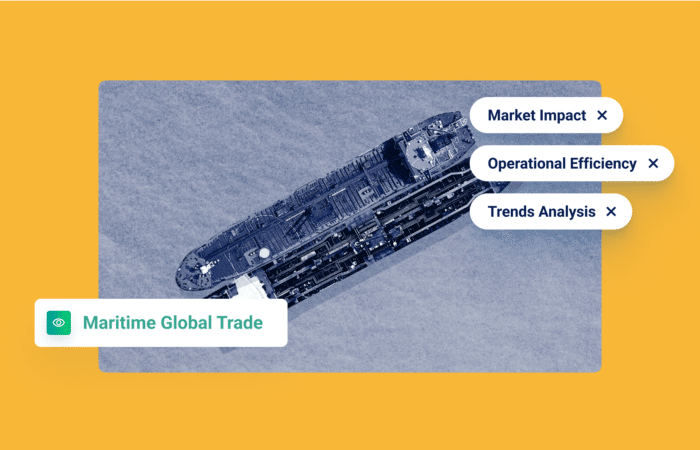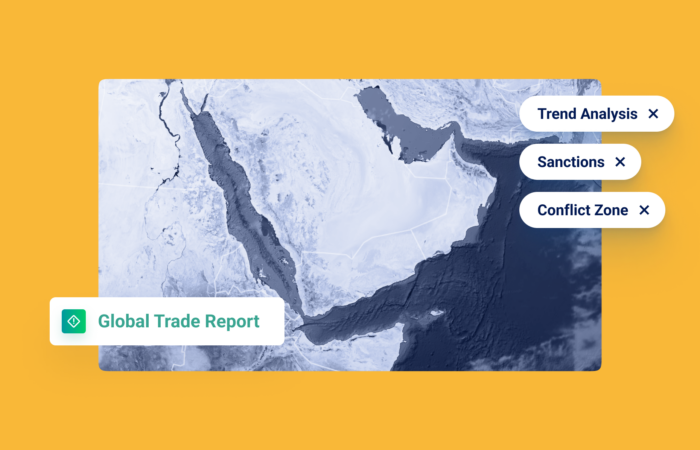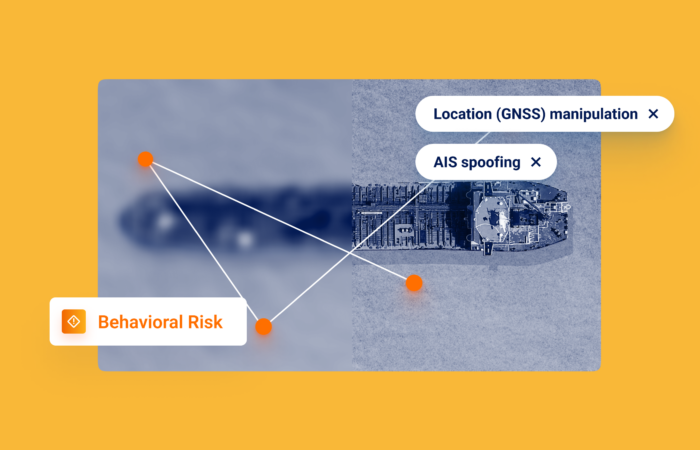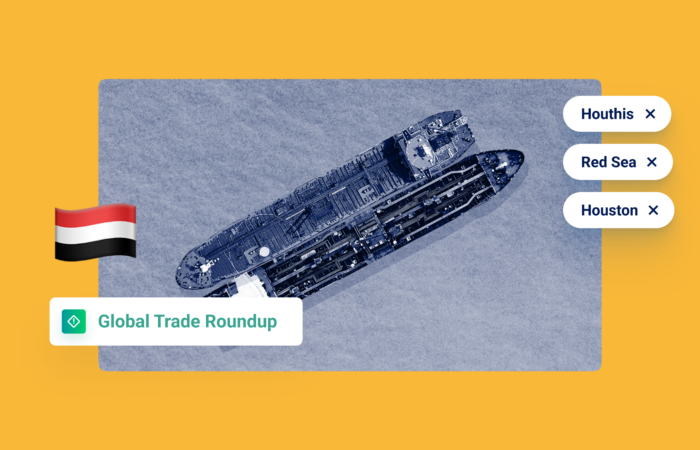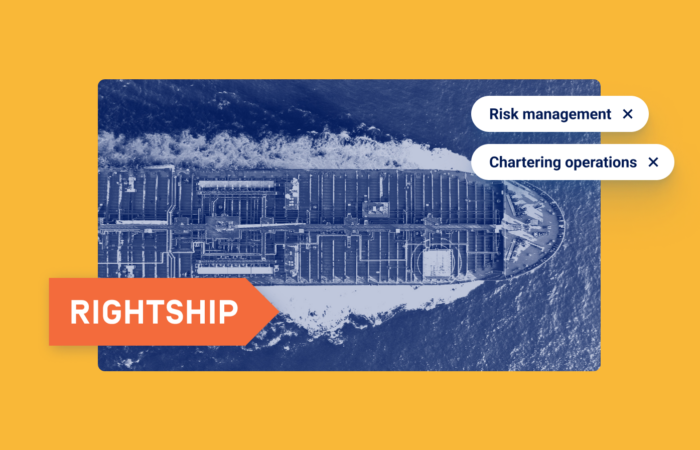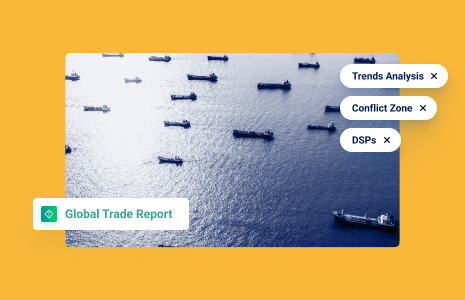What’s inside?
Globally, we’re entering uncertain financial times, as the world economy is facing “one of the weakest paces of growth on record in 2023, according to annual projections released by the World Bank Group, following a year of accelerated inflation, worsening financial conditions and Russia’s invasion of Ukraine,” as noted in Forbes. For the maritime industry, this means that efficiency and ROI will be taking center stage in strategies for 2023, impacting how organizations will manage their risk, decision-making, and vessel selection processes.
The maritime industry is dramatically changing. The lines between sectors are blurring and Russia’s invasion of Ukraine (along with other geopolitical events and conditions) greatly complicated the maritime landscape in 2022. Government agencies are focused on sanctions compliance’s effect on trade flows, and for the first time in history, illegal, unreported, and unregulated (IUU) fishing vessels and some of their supporting cargo vessels are being sanctioned for forced labor abuses.
What does this mean for your organization in 2023? You will need to find more practical tools and technologies to streamline daily workflows, and adopt an agile state of mind in terms of your risk appetite. Enhanced visibility can streamline your business and keep you safe.
2023 obstacles to efficiency & agility
With great knowledge comes… a lot of work. As you are required to track more changes and behaviors, the challenges of being efficient will also increase:
- More data to process
- More solutions to complete the needed due diligence
- More cases to investigate
- More relying on stakeholders to provide information about their operations and location
Three dominant trends
As we all unfortunately witness, new global conflicts can start quickly and unexpectedly. Organizations must be agile, quickly adjusting their risk definition by focusing on what matters to their business, but also considering evolving developments. Whether new sanctioned entities and regimes have been introduced overnight, or a new technology for concealing deceptive shipping practices or illicit activities emerged, companies and organizations must stay ahead of the trends:
- Evolving deceptive shipping practices: bad actors are constantly finding ways to “hide in plain sight” and act as if it’s business as usual. Tactics like Global Navigation Satellite System (GNSS) manipulation are becoming more widespread and sophisticated.
GNSS manipulation or location tampering uses a machine-generated location/path to disguise the true location of the vessel. Multiple methods have been identified to carry out this deception, including false transmission onboard the vessel and third-party onshore accomplices.

- Ownership complexity: as defined by the U.S. Department of the Treasury’s Office of Foreign Assets Control (OFAC), “Complex ownership is inherently complex and involves multiple interactions with government and private sector entities. Bad actors attempt to take advantage of this complexity by using complex business structures, including those involving shell companies and/or multiple levels of ownership and management, to disguise the ultimate beneficial owner of cargo or commodities to avoid sanctions or other enforcement action, among other reasons. If private sector entities cannot reasonably identify the real parties in interest in a transaction, they may wish to consider performing additional due diligence to ensure it is not sanctionable or illicit.”
This maritime trend has been seen before, but with most Russian-owned companies and vessels recently sanctioned almost overnight, complex ownership has become more tricky. To make things even more difficult, a trend of using “front organizations” to mask the real beneficial owners of fleets or vessels is also increasing, to enable bad actors to continue the facade of business as usual.
- IUU fishing: as mentioned above, for the first time in history, IUU fishing vessels and some of their support fleets (cargo vessels) were sanctioned for forced labor abuses, and this maritime trend is quickly evolving.On December 9, 2022, the U.S. Department of the Treasury’s Office of Foreign Assets Control (OFAC) announced in a press release that they sanctioned two Chinese individuals and the networks of entities they control. This action identified 157 People’s Republic of China (PRC) flagged fishing and cargo vessels. It stated that these sanctions “demonstrate the U.S. government’s ongoing effort to impose tangible and significant consequences on those engaged in serious human rights abuse, including on those vessels engaged in illegal, unreported, and unregulated (IUU) fishing.”
IUU long-distance fishing fleets turn to reefers and oil bunkering tankers, known as support fleets, to aid and enable prolonged, seasonally-independent operations. The IUU fishing vessels receive their supplies and discharge their catch without having to call port, or formally report their activities for months, sometimes up to a year or more. The work is often carried out by migrants, who are vulnerable to deception and coercion in recruitment and employment.
“Victims of forced labor are often isolated in inhumane conditions on board fishing vessels and trapped at sea for extended periods of time. Crew members can be subjected to a range of injustices, including physical, psychological, and sexual abuse; unsanitary and unsafe working conditions; 20-hour workdays; lack of pay; and even murder,” according to Oceana, a non-profit ocean conservation organization.
By executing a thorough due diligence process, maritime companies can avoid exposure to sanctions, reputational damage, and financial risk.

3 tips for greater efficiency
There are a few solutions that can easily increase your efficiency, even while coping with the risk trends above:
- Many risks, multiple sources: no single source captures all deceptive shipping practices, or the full picture of what is happening in the fast-paced maritime ecosystem. The ideal solution is multi-source, taking an innovative AI base and fortifying it with daily satellite and on-demand SAR images, supporting imagery analytics to help detect suspicious objects, and imagery integration. With AI-based maritime domain awareness (MDA) platforms and solutions, you can predict where to focus the sensors, bringing tremendous efficiency and value.
- Adopt technologies to decrease dependency on other stakeholders: OPEX on fuel constitutes up to 70% of a vessel’s expenses. Fuel consumption data is reported manually using noon reports – an inaccurate, inconsistent, and costly method prone to human errors. By only relying on the information from these noon reports, stakeholders who are not on board the vessel have little control over the numbers, and many don’t have access at all. By adopting the right AI-powered solution, you can independently and accurately measure fuel consumption and your CO2 performance. This will promote efficiency, cut costs, and is a crucial step to starting your decarbonization journey.
- API integration: streamlining workflows and integrating dynamic risk insights into your existing workflows is a must for operational efficiency. The ideal API can easily customize and enrich any solution with implemented intelligence on areas of interest, vessel behavior, maritime and non-maritime companies, and shipment risk levels via advanced APIs.
For the coming year, wider visibility will be important, with the need for a shared operational picture. In the past, the focus was mainly on high-risk countries like Iran, Venezuela, and North Korea, but now risk is everywhere. Organizations need to be able to shift quickly to define their own risk appetite to align with the frequent changes in this dynamic ecosystem. Maintaining that type of agility while adopting efficiency enhancers – reducing costs, optimizing resource allocation, and increasing ROI – will be key in 2023.


